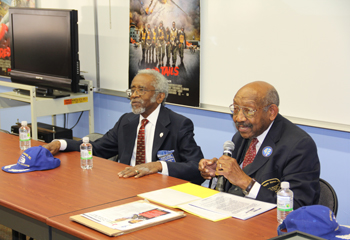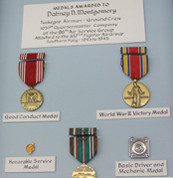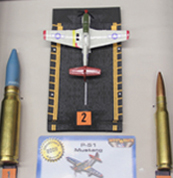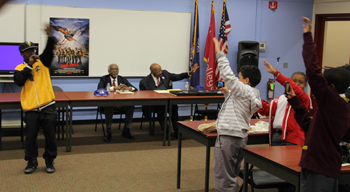
Tuskegee Airmen Visit Vaughn on D-Day Anniversary
“Stand for what is right and true. Always”
That was the message delivered by Dabney Montgomery, 89, to a gathering of grammar school students at Vaughn College on Wednesday (June 6).
“If you’re wounded in life, get up and try again. Don’t stay on the ground.”
Fitting advice on the 68th anniversary of D-Day, June 6, 1944, when Allied forces began the liberation of Europe. At the time, Montgomery and colleague Wilfred DeFour, 93, were members of the prestigious Tuskegee Airmen, the nation’s first African-American pilot and bomber groups. Montgomery and DeFour helped to integrate the U.S. armed forces, then helped to free a continent from Nazi oppression.
On Wednesday, they brought a message of hope and a spirit of nostalgia to Vaughn, which itself helped to train 20,000 technicians for service in the nation’s World War II effort.
“At the time of the formation of the Tuskegee Airmen, there was a belief among the powers that be, that the black man didn’t have the skills to fly a combat aircraft,” DeFour said. “That was proven incorrect. So don’t let anyone in life tell you that you can’t do something.”
A total of about 100 students from Holy Name School and Frederick Douglass Academy in Manhattan found themselves in the company of war heroes on Wednesday as part of Southwest Airlines’ Adopt-a-Pilot program.
Montgomery and DeFour were stationed in Italy during D-Day and had a limited role in the invasion. But the Tuskegee Airmen’s list of accomplishments rivals that of any unit: more than 15,000 combat sorties, one Silver Star, eight Purple Hearts and 150 Distinguished Flying Crosses. Members of 332nd Fighter Group, one of two Tuskegee units, even escorted American bombers in deadly raids over Berlin at the war’s end.
What did D-Day mean to members of the Tuskegee Airmen?
“I’ll never forget it,” Montgomery said. “Hitler was one of the world’s greatest bullies; he thought he was right and everyone else was wrong. The only thing he couldn’t master was the 82nd Airborne Division.”
Much in the news lately with the release of the George Lucas film “Red Tails,” the Airmen were identifiable by the painted red tails on their P-47s and P-51s. Their contributions convinced President Harry Truman to sign an executive order forever banning racial discrimination in the military.
Many Airmen went on to success after the war, including Montgomery who, from Selma, Ala., became a personal bodyguard to Martin Luther King Jr.
Montgomery walked with King during the civil rights leader’s famous march from Selma to Montgomery, Ala. in 1965, but was in New York when King was assassinated three years later.
“It was a terrible shock to us all,” Montgomery recalled. “He believed in what he was doing and was always out there in the public. He was a very courageous man.”
TUSKEGEE AIRMEN VISIT VAUGHN COLLEGE: From top, Wilfred DeFour (left) and Dabney Montgomery entertain visiting students with some living history; medals won by Montgomery during World War II and bullets fired by the Airmen in their P-51s; bottom, rapper Add-2 (Andre DiJuan Daniels) leads the students in a song dedicated to the Airmen.



